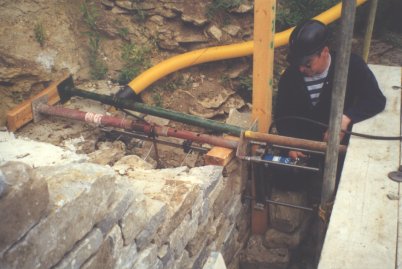 |
|
Masonry Retaining Walls: Typical Problems · Investigation · Designing · Testing · Solutions · Examples · Contact · Home |
|
 IN-SITU LOAD TESTING THE CINTEC GROUND ANCHOR
A feature of the Cintec System is
that a choice of connections can be achieved with regard to fixing to
structure. Traditional anchor head details may be used where periodic
re-stressing or monitoring is required.Where the structure is suitable, the
anchor may be bonded to thematerial as a permanent fixing, without the
requirement for surface apparatus.
|
The general conditions at each
location will dictate the design stresses to be used in assessing the ultimate
capacity of an individual anchor. Where laboratory tests are not available,
full-scale insitu tests are required to establish the lower bounds of the
substrate capacity.
A minimum fixed anchor length of three metres is recommended to account for local variables in substrate conditions. In order to reduce the possibility of long term ground creep, factors of safety should be applied. These factors should be of the order of 3 to 4 dependent on soil consistency, life expectancy and their importance to the structure. The fixed anchor length must be located beyond the critical zone, such as the wedge failure, slip circle, rock discontinuities in order to be effective. The free anchor length will depend upon the geometry of the location. The anchors can act as a restraint, only accepting load if movement occurs, or they can be pre-stressed to a set load to provide an active force. |